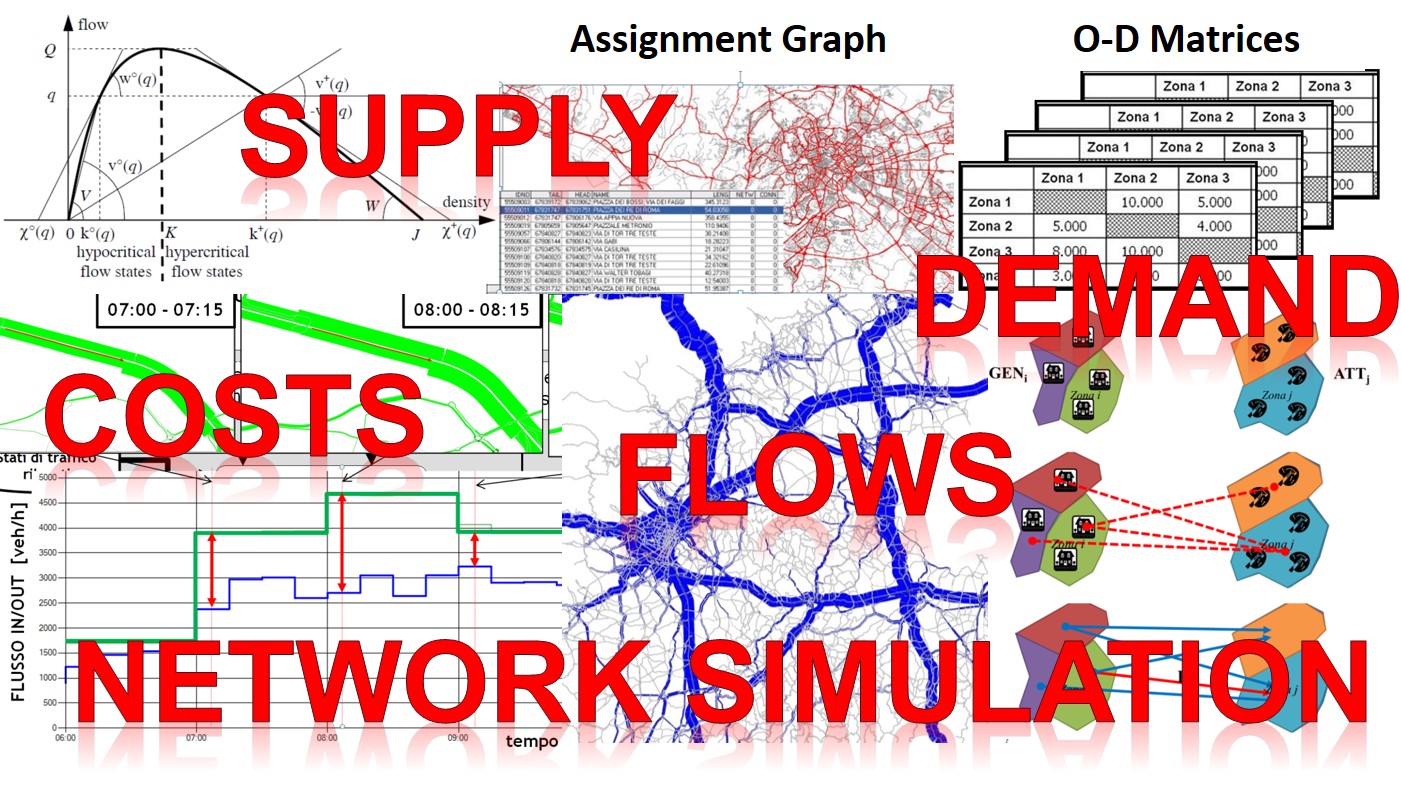Transport Modeling and Planning

Instructor information
Module leader: Prof. Guido Gentile
Course information
ECTS: 12 credits
Status: Compulsory
Semester: 1
Hours: 60/36 (lectures/exercises)
Link: course page
Objectives
To provide a methodological background for the simulation and the design of transport systems, aimed at the evaluation of interventions on the infrastructure and service network, as well as at the application of polices for the mobility of people and goods. The subjects will be developed through phenomena analyses, model definitions, and algorithm applications to elementary cases. A synthesis of the arguments presented in the course is listed below:
- System approach and transport supply (1 credit)
- Random utility theory and passenger demand modelling (3 credits)
- Advanced choice models and freight demand models (1 credit)
- Network loading and assignment (2 credits)
- Equilibrium models and O-D matrix estimation (2 credits)
- Transit assignment (1 credit)
- Dynamic traffic assignment and network design (2 credits)
Syllabus outline
First part:
- Systematic approach to the analysis of mobility. Introduction and scope. Land-use and transport. Structure of models for the simulation of mobility. Zoning the study area. Origin-destination matrix and travel demand characteristics.
- Background on transport supply. Formulation of the supply model. Representation of the road network through a graph. Performance and cost functions. Assignment with explicit path enumeration. GIS and database for transport planning.
- Random utility theory. Discrete choice models. Utility and attributes. Multinomial logit. Nested logit. Cross-nested logit. Probit. Mixed logit. Monte Carlo simulation.
- Demand models. Trip frequency model. Category index model. Generation through regression. Distribution and elementary destinations. Gravity model. Modal split. Aggregation problem. Time series.
- Calibration and validation. Regression and least squares. Maximum likelihood. Stated preferences.
- Route choice and network loading. Route choice models. Network loading with implicit path enumeration. Shortest path algorithms. All-or-nothing assignment. Monte Carlo network loading. Dial algorithm.
- Equilibrium models and algorithms. Fixed-point formulations. Method of successive averages.
Second part:
- Equilibrium models and algorithms. Optimization problem formulations. Variational inequality. Frank-Wolfe algorithm. Bush-based algorithms. Multi-class, multi-mode and elastic demand equilibria. Assignment software.
- O-D matrix estimation. Direct estimation and cordon surveys. Provincialization model. Matrix reproportioning. Reconstruction based on traffic flows.
- Freight transport. Multi-regional input output. Movement generation of pick-up and delivery. Distribution models for urban freights.
- Transit assignment. Representation of the line network though a graph. Frequency-based assignment. Stop model. Strategy-based assignment and hyperpaths. Schedule-based assignment. Departure-time choice.
- Dynamic assignment. Kinematic wave theory. Arc and node models. Dynamic shortest paths. Dynamic network loading. Dynamic equilibrium. Information to travellers.
- Network design. Planning objectives and their evaluation. System optimum and marginal pricing. Network design algorithms.
Essential reading list
- Ennio Cascetta (2009) Transportation Systems Analysis Models and Applications. Springer, ISBN 978-0-387-75857-2
- Lecture slides and exercises provided by the instructor
Recent theses
- Moein Akhavan Gooran (2019-2020) Zone Aggregation in Dynamic Transit Assignment For Real-Time Applications at Intelligent Traffic Management System
- Hamdi Ali (2019-2020) PTV EPICS Opportunity Study to Reduce the Emissions in Urban Areas – ‘Study Case Avenue Mendes France, Strasbourg’
- Fabrizio Vigilante (2019-2020) Healthcare home deliveries route optimization
- Arbra Bardhi(2019-2020) Calibration of a dynamic assignment model for Optima Case study “ITS2020-Dubai”
- Mohamed Eldafrawi(2019-2020) Dynamic OD matrix estimation methodology for congested networks
- Nazar Tarlanli(2019-2020) Development of a methodology to extract Route Choice Sets out of GPS trajectory data by mean of clustering techniques
- Amirhossein Sarfi(2018-2019) Inferring Day-Types using Flow Profiles of Loop Detectors by means of Machine Learning Techniques
- Dayana Bou Shakra (2018-2019) Smart Working: in the Context of Mobility Management
- Eleonora Bonoli (2018-2019) A new way to promote sustainable mobility: a gamification app
- Riccardo D’Antoni (2018-2019) Analysis of mobility behaviour and transport demand management. Case study: Tiburtino Industrial Site
- Pedram Tafazoli (2017-2018) Integration of PTV Optima and Balance aiming at Intelligent Traffic Management System (ITMS)
- Danilo Guitto (2017-2018) Emission models analysis: Mobility impacts in the corporate social responsibility
- Matteo Giaconi (2017-2018) Validation for a Dial-A-Ride software and a sensitivity analysis
- Lory Michelle Bresciani Miristice (2017-2018) Simulation of Congestion Phenomena on Transit Networks
- Mariano Biasella (2016-2017) Emission models analysis: Comparison between COPERT and MOVES methodologies applied to a macroscopic and mesoscopic simulation


